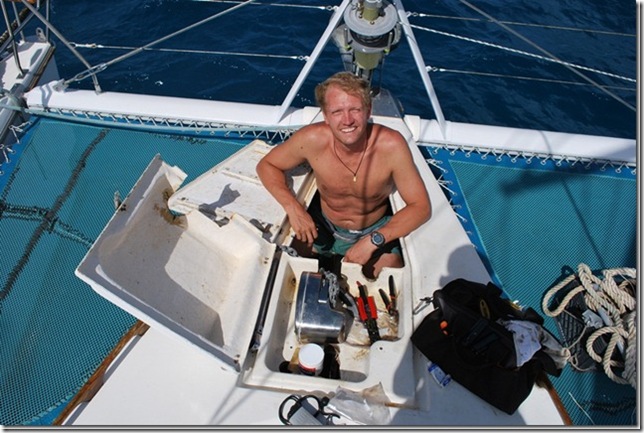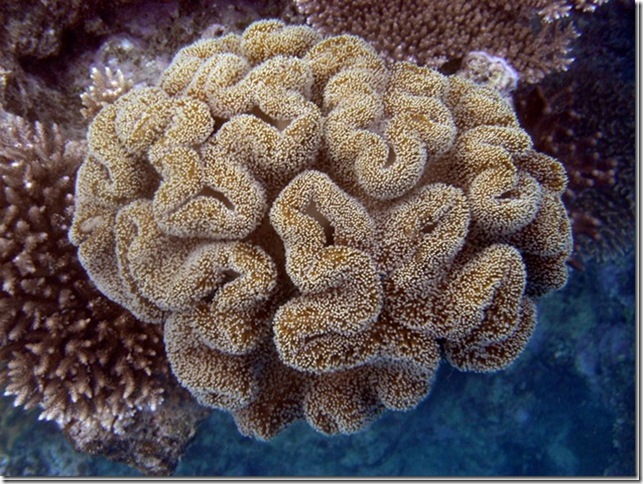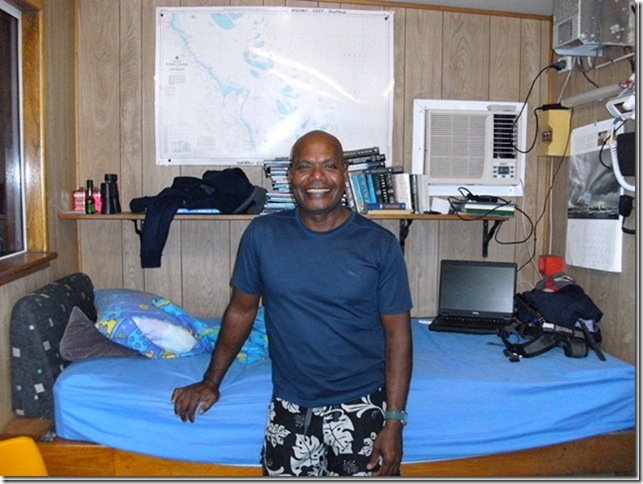Lat: 16 25.886′ S
Lon: 145 59.209′ E
Our first full day on the Great Barrier Reef (GBR) started with something new — sunny skies. There was still plenty of wind, but at least it was pleasant and warm outside with the colors of the reef much more visible than the day before.
We’d planned to start the day with an early dive, but decided instead to try to fix the windlass, which would be pretty useful if we needed to leave the public mooring and anchor (our allowed time on the public mooring was up at 9am, but nobody had come to claim it). This type of problem is usually wiring, but after all the wiring and the remote checked out, I had a bit of a sinking feeling; the problem was the windlass itself. The windlass didn’t do anything at all, so it had to be some sort of electrical or motor problem. I’d never worked on a windlass or electric motor before, but the windlass is a really useful piece of gear (without it we’d have to pull the chain and anchor in by hand), so I thought I’d give it a shot. With the help of the windlass manual and of course Nigel Calder’s book I was able to get the motor removed and disassembled and determine that two of the four brushes were stuck in their guides. Watching the autopilot servicing the other day was actually pretty useful, as many of the steps were similar. After removing the armature, cleaning the commutator, and freeing the stuck brushes the motor seemed to be working just fine. It took about 5 hours, but by 2pm everything was back together and seemed to be working just fine.
Four hours later it’s almost all back together. Now if I could just get a haircut…
Next it was time to actually enjoy the reef. Norman Reef is a heavily visited tourist destination. There are numerous dive sites and moorings and there’s even a large pontoon, a two-story covered platform roughly 50′ wide and 250′ long. There’s also a floating helicopter pad and a boat with a 10′ deep glass-walled underwater reef-viewing chamber. We headed over to the pontoon where we’d read there was a large Maori wrasse named Wally that was friendly with the divers who feed him. Unfortunately the day boat that brings 200-300 people at a time to the pontoon was there and they asked us to come back later when they’d left, so we dinghied over to a nearby mooring and snorkeled a couple of large reef structures.
 (L-R) Sub/boat, helicopter pad, ferry to the chopper pad, and day-boat tied to the large pontoon
(L-R) Sub/boat, helicopter pad, ferry to the chopper pad, and day-boat tied to the large pontoon
The fish here are the most amazing we’ve seen. Most of the species are the same, but they’re much larger and much less afraid of people. I don’t know how long this particular reef has been protected, but it’s in pretty good shape, especially considering the number of tourists that visit on a daily basis. There was no shortage of fish to try and photograph, including one fish that was working on a crab dinner. Several crab limbs were jutting out of his mouth and he was trying to work them all in without losing any to the quite interested fish swimming around him.
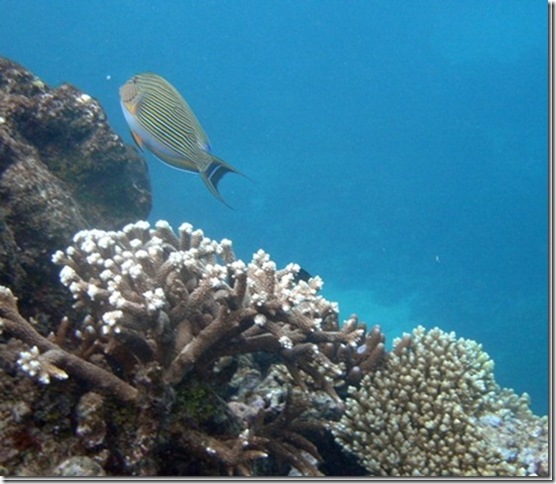 Lots of colorful fish and nice coral
Lots of colorful fish and nice coral
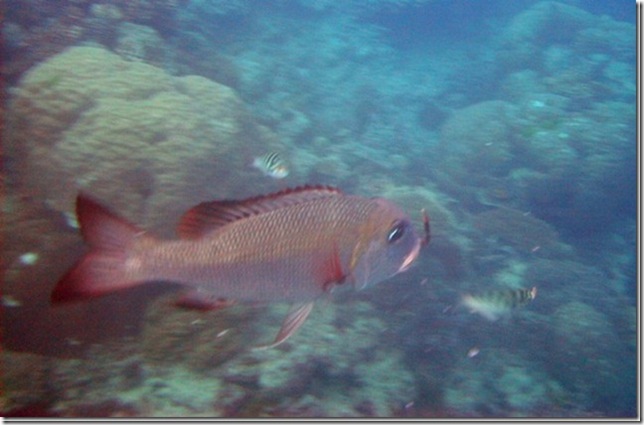 This guy was trying to munch down the rest of the crab before it got stolen right out of his mouth
This guy was trying to munch down the rest of the crab before it got stolen right out of his mouth
Once the tour boat had left, we made our way over to the pontoon and met Wilson. Wilson is from the Solomon Islands and spends four nights a week on the pontoon by himself. It’s his own little island. He showed us around and told us to make ourselves at home, gave us a few tips on where to dive and snorkel, and even told us to grab a couple of cold drinks from the cooler in the restaurant area. We asked if he liked lasanga (there’s still more left) and agreed on a lasagna dinner on the pontoon. The pontoon is set up for all sorts of diving activities and also includes a restaurant area with tables and a sun deck. We walked down into the underwater fish-viewing portion of the pontoon and saw Wally resting under the pontoon, so we lowered one of the diving ladders and walked in to have a closer look. He wasn’t quite as friendly as we’d hoped, but we did get a nice shot of Lauren chasing him. He’s about the size of her torso.
After checking out Wally, we dove out from under the pontoon and headed for the main snorkeling area. Wow! It was easily the best snorkeling we’ve ever seen. The coral was varied and healthy, the water was shallow enough that the visibility and light were good, and there were lots of large, colorful fish, as well as giant clams. The first large creature we saw was a white-tipped reef shark about four feet long. I followed him for a while to video him swimming along, but he seemed to be more interested in getting away from me than in helping me out with a nice video. Next, a really big humphead parrotfish came swimming right toward us. It was at least 3 times the size of the largest parrotfish we’d seen. It’s jaws of fused teeth, looking like the beak of a parrot were open and clearly visible as he swam by. I was following him with the camera taking video when he made a sharp turn and took a such a big bite of coral that you can even here the crunching sound in the video that our low-end underwater camera made.
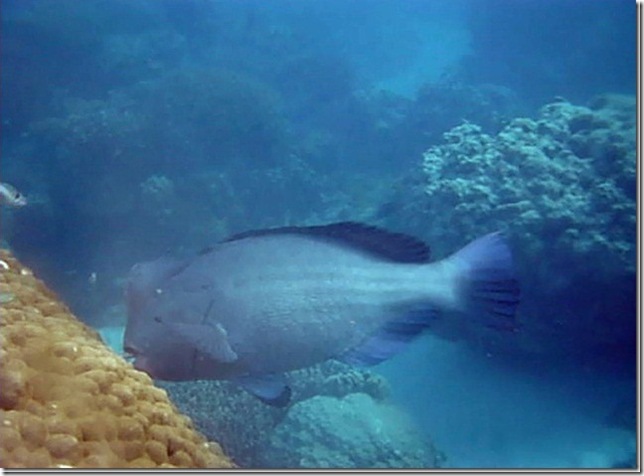 Large humphead parrotfish about to take a big bite of coral
Large humphead parrotfish about to take a big bite of coral
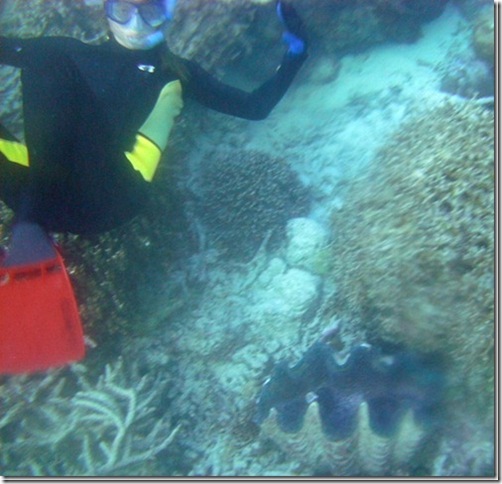 Lauren with a giant clam (they can get to be twice that size)
Lauren with a giant clam (they can get to be twice that size)
We’d really enjoyed snorkeling, but we wanted to try a dive, so we motored over to the spot Wilson had pointed out. I didn’t want to try tying off to dead coral on the top of the “bommie” (giant coral head), so we tied off to a nearby mooring and swam over through the open water. When we got there and dropped down, there were six large barracuda and a fair amount of current waiting for us. By time we reached 20′ or so, two 5-6′ sharks swam by. One was a white-tip and the other was one we haven’t seen before. He was a bit more active and aggressive-looking, with a smaller blue fish that seemed to be stuck to his tail and hitching a ride. Visibility wasn’t great and it was getting near dusk, but we still saw plenty of large fish in the 25-minute trip around the giant head. One of my favorites was a group of fairly large ones that were black with white fan-tails and a growth above their mouth that stuck out like a Pinocchio nose. After seeing the same two sharks again, and completing our trip around, we headed back for the dinghy.
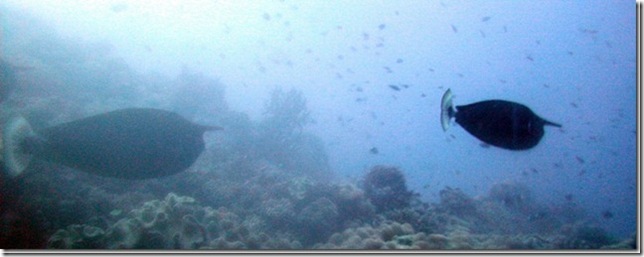 If these aren’t called Pinocchio fish, someone screwed up
If these aren’t called Pinocchio fish, someone screwed up
It was a wet ride back to the boat, but we changed, rinsed the gear, and headed over to see Wilson for dinner, which was really nice. He brought out some cold drinks and we had a nice conversation. Apparently they only take him off the pontoon if it’s going to get a direct hit from a hurricane. He’s stayed on through a couple of hurricanes, but the last one was strong enough that they decided to pull him off. By time the boat was there to get him, though, the waves were breaking onto the second story of the pontoon and the best the boat could do was to wait nearby while Wilson swam out to them through the wind and waves. After dinner we enjoyed a little American television thanks to the magic of satellites and electric generators. It was the first time in over a year that Lauren and I had watched American television together.


